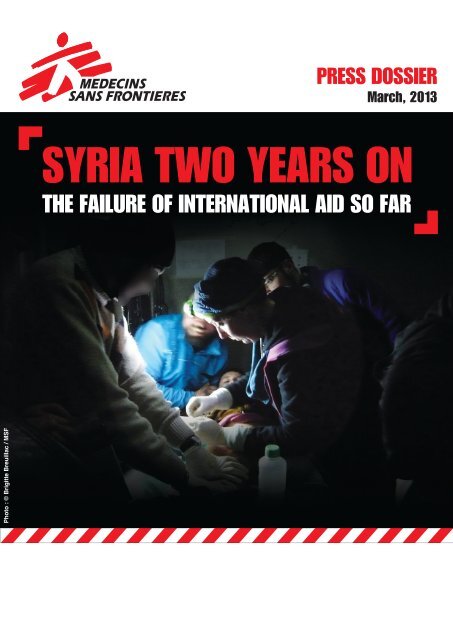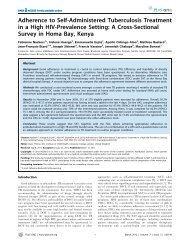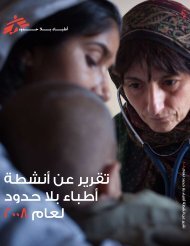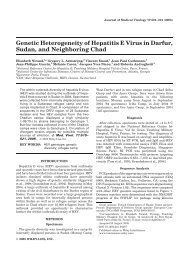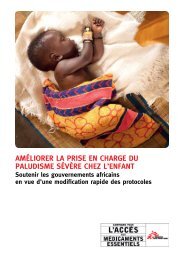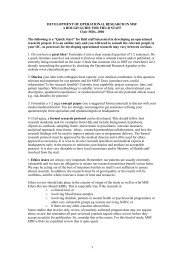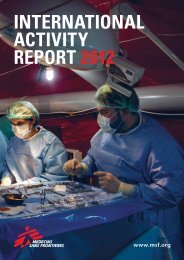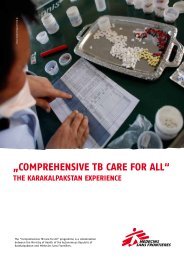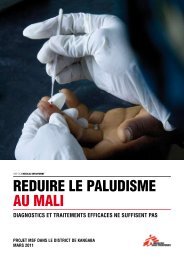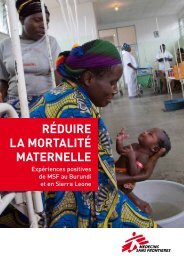Syria Two Years On (PDF)
Syria Two Years On (PDF)
Syria Two Years On (PDF)
- No tags were found...
Create successful ePaper yourself
Turn your PDF publications into a flip-book with our unique Google optimized e-Paper software.
<strong>Syria</strong> report<strong>Syria</strong> <strong>Two</strong> <strong>Years</strong> <strong>On</strong>The Failure of International Aid so farAfter two years of an extremely violent conflict whichhas resulted in more than 70,000 dead according to theUN, the <strong>Syria</strong>n people are faced with a humanitariancatastrophe.Despite repeated requests, MSF has not receivedpermission from the government to work in thecountry, but has been able to open three hospitals in theopposition-held areas in the north where assistanceremains well below the level of the needs.3
<strong>Syria</strong> report1. Healthcare in dangerFrom repression to all-out destructionSince the first protests broke out in <strong>Syria</strong> in March 2011, the country has spiralledinto all-out war. Violent fighting continues between the national army and oppositiongroups who have gained territory – and civilians pay a heavy price.As the conflict intensifies, health workers and medical facilities continue to receivethreats while medical structures are targeted and destroyed. Here we reflect on twoyears of conflict in <strong>Syria</strong>, and the mockery made of the concept of medical care inthe country.Injured people arrested, doctors hunted downA revolutionary movement shook <strong>Syria</strong> in early 2011, as in other countries in the Arab world. Thefirst major protests took place on 15 March 2011 in Damas. As the weeks wore on, the number ofprotesters multiplied and soon found themselves under fire as security forces attempted to quell theuprising. The activists assumed that they could seek care at public or private hospitals should theyneed it, as health structures had the technical means, expertise and resources necessary to treattrauma. <strong>Syria</strong>’s health care system had once functioned to a high standard. But very quickly thehealth structures were targeted in the campaign of repression.Accounts from doctors and patients revealed that hospitals were being scrutinised by the securityforces, and that people were being arrested and tortured inside them. Doctors risked being labelledas ‘enemies of the regime’ for treating the injured, which could lead to their arrest, imprisonment,torture or even death. People injured in protests stopped going to public hospitals for fear of beingtortured, arrested, or refused care, and were essentially forced to entrust their health to clandestinenetworks of medical workers.In Deraa, Homs, Hama, and Damascus, medical care was still provided, out of public view. Makeshifthospitals were set up inside homes near where protests were taking place. Health centres treatingthe injured would provide false official diagnoses in order hide that they were treating wounded. Themajor concern for doctors working in these underground networks was their safety.Healthcare goes undergroundAs fighting intensified, an increasing number of medical facilities were affected. In July 2011, the<strong>Syria</strong>n army deployed tanks in the city of Homs; in February 2012, the city was under constant attackby snipers, shelling and aerial bombing by the air force. Aid efforts continued clandestinely; medicsworked as bombs rained down around them. The authorities refused to allow international humanitarianaid into the country, and a ceasefire to evacuate the wounded was also rejected.A handful of makeshift hospitals were providing healthcare close to the conflict zones. They hadbeen set up in caves, individual homes, farms, and even in underground bunkers. Following initialtreatment and stabilisation, patients were transferred to hospitals in safer locations.4
<strong>Syria</strong> report2. Civilians caught upin the cycle of violenceIn the regions in northern <strong>Syria</strong> where MSF is working, people have suffered greatloss and devastation. This is especially true in the urban and semi-urban areas thatare bombed indiscriminately and where there are large gatherings of people, suchas markets and bread queues – which have been targeted by the air force.In addition to the physical devastation, the country’s social and economic systemshave broken down, and civilians are the first to suffer. Despite a massive outpouringof local solidarity, the ongoing conflict has brought the healthcare system to itsknees, while living conditions have severely deteriorated. Meanwhile, resources arerunning out and peoples’ capacity to help each other is being tested.Civilians terrorisedSince starting work in northern <strong>Syria</strong>, MSF hasbeen witnessing how the violence is directlyaffecting civilians. Patients injured by shrapnelor bombs at the market or even in the breadlinemake it to hospital only thanks to the efforts oftheir fellow citizens willing to help each otherdespite the distances to health centres and theconstant threat of bombings.“Some villages are hit by rocket fire or haveexplosives dropped on them by helicopters ona daily basis,” says Katrin Kisswani, an MSFcoordinator in <strong>Syria</strong>. “This has had a devastatingeffect on people. A few days ago, a helicopterdropped a couple of barrels with TNT and bits ofmetal inside right in the middle of a village. Wetreated the victims in our field hospital – someof them were women and children.” Duringexploratory missions, MSF teams have alsocome into contact with people who had beenliving without any outside assistance at all.Civilians have been traumatised by the conflictand live in constant fear of gunfire, rocketsand missiles. They are even suspicious of oneanother: sometimes they would not give theirreal names out of fear their stories would becomepublic and their families would be threatened.<strong>On</strong> 13 January of this year, 20 people were killedand 99 injured after a marketplace was bombedin Azaz. MSF treated 20 of the wounded, allof them civilians including five children. <strong>On</strong>lytwo days later, a further 44 patients receivedemergency treatment in another MSF facility,after several barrels of explosives were droppedon a village and a rocket landed in Idlib province.8
<strong>Syria</strong> reportFear of planesFaotum H. 55 years-old, sits outside an MSF hospital after visiting her grandson. She recalls thebuzzing of <strong>Syria</strong>n warplanes over Azaz, a town in northern <strong>Syria</strong> close to the Turkish border, in thesummer of 2012. An airstrike hit her home, though no one in her family was injured as they were nothome, but the second floor was completely destroyed. The large hole and debris from the impactremained as physical reminders of the attack.A few months later Faotum’s grandson, six year-old Mohammed, was playing at home with hisbrothers when warplanes flew over Azaz.The kids panicked and started to run downstairs. Mohammed did not see the hole and felldown it, broke his leg and injured his head,” says the grandmother. It wasn’t an airstrike, butthe sound of the planes was enough to frighten the children and send them running. The boywas treated at an MSF field hospital in the region. His grandmother is relieved but remembershow hard it was to find medical assistance. “We were told in Azaz that we had to go to Turkey.In the end we came here, and he was admitted.Man wounded waiting in a bread queue in Halfaya (Hama province)<strong>On</strong>e afternoon at the end of December, I was waiting at the bakery to buy bread. There wereabout 300 people in the queue – it’s the only bakery in town that’s still open. I’d been waitingfor three hours when suddenly a plane flew overhead and two missiles hit us.There was screaming all around me – many people had been wounded. I felt disoriented; I feltas though my lips and tongue were burning. Injured people were loaded into vehicles. I wastaken to a health centre – first in a wheelbarrow, then by motorcycle taxi. I was unconsciousfor three days. The second day, my brother brought me to another medical centre beforefinally bringing me here to the MSF hospital in a van. That’s when they operated on me.I’m still having problems with my ears – there’s constantly a ringing in them and I can’t reallyhear. The incredible thing is that my two daughters came away from it okay. A semi-collapsedwall protected them from the explosion, so they only had a few cuts and scrapes.At the MSF hospital, a surgeon cleaned this man’s wounds and the parts of it that had becomenecrotic, and sutured the small cuts on his face. The size of the wound on his left shoulder and theseverity of the injury to his right hand meant that he had to be transferred to a hospital in Turkeyfor reconstructive surgery, as the MSF facility isn’t equipped to carry out such complex procedures.9
<strong>Syria</strong> reportA health systemin collapseBefore this conflict, <strong>Syria</strong> had a well-functioninghealth system. The country has trained healthworkers, medical expertise and a pharmaceuticalindustry. But today resources are depleted.Health networks are breaking down because ofsupply problems and drug shortages resultingfrom the collapse of the pharmaceutical industryor indirectly from international sanctions imposedon <strong>Syria</strong>.The intense violence makes accessinghealthcare very difficult. In Homs, Aleppo andin the area around Damascus, snipers presenta constant danger. Moving from one area to theother is often impossible, and entire communitiesare consequently deprived of medical care.In a medical emergency, patients face a grimdilemma: either forgo medical attention or riskfinding themselves in crossfire..Patients are often sent to under resourced healthfacilities, if they’re lucky enough to receive anycare at all. In many hospitals care is first given tocombatants, but large numbers of patients alsoneed medical attention, be it for chronic illnesses(e.g. diabetes, cardio-vascular diseases, andkidney failure), obstetric care and post-operatorycare, and have difficulty accessing care.« Many health facilities have closed becausethey lack essential equipment, and others areconcentrating only on trauma. This makes itthat much more difficult for people to accesshealthcare,” says Miriam Alia, an MSF medicalcoordinator in <strong>Syria</strong>. “In the regions where we’vebeen working, the children haven’t receivedvaccinations in the last 18 months. They’renot protected against contagious diseases likemeasles and tuberculosis. Sanitary conditionsare worsening as water is so scarce which alsoincreases the risk of disease. »Recently there have been reported outbreaks ofthousands of cases of cutaneous leishmaniasisin northern Aleppo province. Local doctors inDeir ez-Zor reported to MSF that 1,200 cases oftyphoid fever, which can be fatal, and 450 casesof cutaneous leishmaniasis had been registeredby the end of February. Drugs for tuberculosishave been unavailable in the region for months.Diabetic patients require regular treatment andfollow-up but at present they have been left totheir own devices. « Without insulin, patientsare coming in with blood sugar levels of up to5 grammes/litre, and we have had some witha gangrenous foot that requires amputation, »says Anne-Marie Pegg, an MSF emergencydoctor.Giving birthin a war-torn countryPrior to the conflict, 95% of <strong>Syria</strong>n women gavebirth with a skilled birth attendant. With thegradual collapse of the health system, this is nolonger an option for most of them. If a pregnantwoman is lucky, she might give birth with thehelp of a midwife or a traditional birth attendant.However women with complicated deliveriesrequiring surgical care have great difficulty infinding an appropriate facility.<strong>On</strong> 1 February of this year, a woman gave birthto twins by Caesarean section at an MSF clinicin northern <strong>Syria</strong>. The father of the twins saidthey searched for two weeks to find a hospitalcapable of performing the surgery.In the MSF hospital in Aleppo province, deliveriesclimbed from 56 in November 2012 to 183 inJanuary 2013. MSF’s medical teams have seenan abnormally high number of miscarriages andpremature births among their patients, morethan 30 in December and January alone. This isdue to the stress generated by the conflict.10
<strong>Syria</strong> reportDeteriorating living conditions« Most of the families have fled the village.There’s no gas, electricity, or bread, and thephone lines are dead. There is nothing to live off,»says a housewife from Idlib province.The cost of living has increased considerably,and bombing has cut off the supply of water andelectricity in the north of the country. Since thebeginning of December 2012, there has beenno electricity in the eastern part of Aleppo, inAl Bab, and in the entire region up to Kilis. Theprice of fuel has risen significantly and now thatit is winter, conditions are constantly cold andmoist. People are using wood or fuel stoves tokeep warm, which are often the cause of seriousaccidents.MSF’s Elisabeth Jaussaud, who has returnedfrom east Aleppo, says, « In Aleppo, everythingthat even resembles an administrative buildinghas been bombed. There’s no power in Alepposave for the generators. The city is littered withpiles of rubble that block the streets so that carsor armoured vehicles can’t pass. Rubbish too ispiling up all over the city. »Another issue is the supply of food. Food priceshave increased sharply in the northern provincesof <strong>Syria</strong> where MSF is present (Latakia, Idlib andAleppo), so there have been major shortages offlour and baby formula. In response, MSF hasdonated baby formula and several tonnes offlour in Idlib and Deir ez-Zor provinces.« <strong>On</strong>ly a few markets are open. Factories areclosed. When food and vegetables are available,they are too expensive,» says a mukhtar or headof a village, who did not wish to be identified.Displacedand isolated peopleAccording to the Office of the UN HighCommissioner for Refugees (UNHCR), two anda half million <strong>Syria</strong>ns have been displaced insidethe country since the first protests broke out twoyears ago. Most of the displaced people are notliving in camps – many settle in buildings andpublic places, or are constantly on the move.Living conditions are very poor for the internallydisplaced, while host communities are alsounder strain.Access to large parts of the country is still verydifficult. As you go south from the Turkishborder, the level of assistance decreases. It isalso difficult for assistance to reach denselypopulated areas and the desert regions in theeast. The food shortages are so acute thatcurrent supply and solidarity networks cannotcope.In areas under government control, such as thewestern parts of Aleppo city, people are living inenclaves surrounded by the armed opposition. Itis impossible to supply humanitarian assistancefrom Damascus into these areas.Faced with a situation that is relentlesslyworsening, an increasing number of <strong>Syria</strong>ns arefleeing the country. According to the UNHCR,one million <strong>Syria</strong>ns have been either registeredor are waiting to be registered as refugees mainlyin the neighbouring countries of Iraq, Jordan,Lebanon and Turkey. More than 150,000 ofthem arrived in February alone.So far, aid for <strong>Syria</strong>n refugees has not beensufficient to effectively respond to their basicneeds. Meanwhile, their living conditions havecontinued to worsen through the harsh winterconditions and sub-zero temperatures.11
<strong>Syria</strong> report3. Obstacles to increasing aidfor <strong>Syria</strong>There are major obstacles preventing the increase of aid to both government andrebel-held areas. The government is limiting humanitarian aid; because of thecontrol exercised by Damascus, assistance can hardly be expanded and aid organisationsface huge difficulties crossing front lines. Meanwhile, in the north of thecountry, insecurity caused by fighting and bombing is compounded by political anddiplomatic constraints , seriously limiting the amount of aid.Control of assistance in government areasSince 2012, international aid for <strong>Syria</strong>ns inside the country has been mainly deployed from Damascusby the International Committee of the Red Cross (ICRC), UN agencies (including WFP, UNHCR,UNRWA, etc) and about a dozen international NGOs. This assistance is channelled through the<strong>Syria</strong>n Arab Red Crescent and local organisations, which are authorised by the <strong>Syria</strong>n governmentto distribute the aid on the ground. Operations are also under the responsibility of the <strong>Syria</strong>n Vice-Minister of International Affairs and Expatriates.Though there is currently insufficient humanitarian aid to meet the massive needs, it will be difficult toget more – and more effective – aid into the country. For one thing, the government is not permittingany more international NGOs to work in government-held territory – indeed, MSF has been refusedaccess to these areas, despite several requests. Also, humanitarian aid organisations are requiredto distribute aid through local organisations, who are already operating at full capacity and whosescope of operations is limited geographically.These constraints also significantly limit the capacity of aid agencies tolerated by Damascus to reachpeople in the opposition-held north of <strong>Syria</strong>. According to Valerie Amos, UN under-secretary-generalfor humanitarian affairs, other options for aid distribution, like humanitarian operations led fromneighbouring countries, are not currently feasible without government authorisation or a separateUN Security Council resolution.Aid to rebel-held areas - limited and piecemealAbout a dozen international NGOs are present at the <strong>Syria</strong>n borders attempting to get aid into thecountry’s interior. This aid was first limited to sending medical supplies for groups of <strong>Syria</strong>n doctorsworking clandestinely to treat injured people in makeshift hospitals. Some aid has been provided inthe displaced peoples’ camps along the Turkish border. MSF first started supporting these doctorsthis way. With the consolidation of territory controlled by the opposition, MSF was able to enter andopen three hospitals in the north of the country. This was done unofficially, as MSF remains forbiddenby Damascus to work in <strong>Syria</strong>n territory.Beyond that, most aid for civilians comes from three sources: the <strong>Syria</strong>n diaspora, countries “sym-12
<strong>Syria</strong> reportpathising” with the opposition (Saudi Arabia, France, Turkey, Qatar…), and political and religioussolidarity networks; thereby subject to the political agendas of these actors.Meanwhile, indiscriminate or targeted bombing considerably limits the amount of aid provided inthe north of <strong>Syria</strong>. Aid is distributed through local organisations (such as of doctors, businessmen,etc.), armed groups, and civil authorities trying to establish themselves (such as local revolutionarycoordination councils). Narrow areas along the borders are de facto exempt from the bombing. Butthe supply of aid dwindles further inland from the border, such as in the Deir ez-Zor region, which isparticularly neglected.Another obstacle for the provision of aid is of a political nature. In the north of <strong>Syria</strong>, internationalaid providers are struggling to find ways to collaborate efficiently with local authorities and <strong>Syria</strong>naid networks. <strong>On</strong>e issue is that there are many representatives and leaders. Humanitarian actorsstruggle to gauge the real importance and operational performance of the different representativesthey come across. Futhermore, humanitarian actors distrust them all the more as these persons canbe affiliated with different and competing networks (political, military, or religious, for example).The final obstacle is administrative. Though neighbouring countries tolerate NGOs engaged incross-border humanitarian operations into <strong>Syria</strong>, they are not willing to grant them the logistical andadministrative support that comes with official permission. Aside from slowing down the delivery ofaid, this semi-underground status also conflicts with the financing rules for some donors who arereluctant to fund NGOs carrying out cross-border operations.What makes this even more of a paradox is that the EU, Turkey and almost 130 other countriesrecognise the <strong>Syria</strong>n national coalition as the sole representative of the <strong>Syria</strong>n people, and providethem with direct financial and (officially non-lethal) military aid. This being the case, it’s hard to seewhat is stopping <strong>Syria</strong>’s neighbouring countries and these financial donors from officially recognisingand providing financial support to humanitarian cross-border operations.Danger of humanitarian operations across frontlinesAlthough the current set-up is intended to cover all the existing needs in <strong>Syria</strong>, the national andinternational aid provided beyond areas controlled by Damascus is limited. This is due to the hugedifficulty involved in imposing a temporary ceasefire, which would be necessary to get material andteams collaborating with the <strong>Syria</strong>n Red Crescent safely across the front lines. A spokesperson forthe ICRC who was recently in the country summed it up in a recent public statement: “ Mountingcross-line operations is challenging, not least because – as in every conflict – neither side is keento see us crossing into the area held by their enemy.” Armed rebel groups, meanwhile, show greatmistrust towards the <strong>Syria</strong>n Red Crescent, which is perceived as pro-governmental – despite thededication of its members (since the beginning of the conflict, seven Red Crescent volunteers andeight UN employees have been killed on-mission).To cover the needs of civilians, the capacity of humanitarian actors to provide impartial aid on thewhole <strong>Syria</strong>n territory must be increased and cross-border operations must be facilitated, as a matterof urgency.13
<strong>Syria</strong> reportInsufficient aidAt the end of January 2013, more than 60 countries committed to providing more than 1.5 billiondollars in humanitarian aid for the <strong>Syria</strong>n population. This amount, meant to cover urgent humanitarianneeds for the first half of this year, can be contrasted with the small sum that the UN Office for theCoordination of Humanitarian Affairs (UNOCHA) was actually able to obtain to cover its action planin 2012.The plan for 2013 includes a regional response for refugees, estimated at $1 billion US for 1.1 millionpeople, and another estimated at $520 million US for 4 million people “directly or indirectly affectedby the current events” inside <strong>Syria</strong>. Yet, as of 19 February, the UN action plan had only received20% of the necessary financing.This aside, the difference between the amount of financing for aid going to refugees and the amountallocated to <strong>Syria</strong>ns inside the country illustrates that the current system is unable to respond to thecurrent emergency inside <strong>Syria</strong>.14
<strong>Syria</strong> report4. Assistance Failing<strong>Syria</strong>n refugeesAccording to official estimates, 1 million <strong>Syria</strong>n refugees are registered or awaitingregistration in <strong>Syria</strong>’s neighbouring countries - Lebanon, Jordan, Turkey and Iraq.But their actual number could be much higher as many people are not in theprocess to be registered as refugees. In the past months as many as 7,000 peoplehave been fleeing <strong>Syria</strong> each day. Most of them are reported to be women andchildren.The situation of the refugees fleeing <strong>Syria</strong>emphasises the failure of the international aidsystem to respond to the <strong>Syria</strong>n crisis. Althoughaccess and security in the neighbouring countriesare not a major problem, the international aidsystem has failed at anticipating and respondingto the growing needs of the refugees. Themassive influx of refugees pouring into <strong>Syria</strong>’sneighbouring countries is weakening furtheralready fragile refugee reception set-ups andworsening the already dire situation of scatteredrefugees in Lebanon.In Jordan and in Iraq the living conditions inthe refugee camps are grim. The camps aresaturated and hygiene is poor, due to shortagesof latrines and showers. People are living incrowded and unheated tents that offer littleprotection against the bitter winter. Earlier thisyear rainstorms and snow have plunged somecamps into no refuge.In Lebanon where there are no official campsfor <strong>Syria</strong>n refugees, an increasing number ofpeople live in inadequate collective shelters,farms, garages, unfinished buildings and oldschools. According to a survey conducted byMSF in December, 50% of the <strong>Syria</strong>n refugees inLebanon are not receiving the required medicaltreatment because they cannot afford it. Foodalso is a growing issue. MSF teams have seencases of women having to feed their babies withtea because they could not afford to buy milk.Psychological distress is widespread amongthe refugees whether they are men, women orchildren. Most of the refugees interviewed byMSF in Lebanon and Iraq reported they fled<strong>Syria</strong> because of the insecurity but also becauseof the deterioration of their living conditions in<strong>Syria</strong> (shortages of food, water and fuel and lackof access to medical care).Thousands of <strong>Syria</strong>n refugees face anunacceptable situation. After fleeing a war zoneand leaving everything behind them, people stillhave to wait weeks or even months before theyare officially registered as refugees and receivea much needed assistance. Many families areliving in dire conditions with very little assistance,while others simply not getting any aid at all:roughly one in four of the registered refugeesinterviewed in Lebanon said they had notreceived any assistance, while 65% said theyhad received only partial assistance that did notcover the families’ needs.For Iraq, Jordan, Lebanon and Turkey, whichhost nearly all the <strong>Syria</strong>n refugees, the costtoday is growing and the host populations whohave been very welcoming over the past twoyears are no longer able to carry this burden.Despite the solidarity and the tremendousefforts of these countries to cope with the crisis,the various aid structures and schemes put inplace are today dysfunctional and will most likely15
<strong>Syria</strong> reportremain so if the influx of refugees continues.A late recognition of the magnitude and durationof the crisis and the ever growing numbers ofrefugees are the main reasons that explainthe delays in the deployment of a responsecommensurate with the needs. But the levelof assistance to the <strong>Syria</strong>n refugees must beurgently increased today in order to avoid afull blown humanitarian crisis. There must bea more expansive, concerted, and effectivehumanitarian response to provide these peoplewith a relief from the conflict plaguing <strong>Syria</strong>,and ensure that their humanitarian and medicalneeds are met.Since 2011 MSF has expanded its work with<strong>Syria</strong>n refugees in Lebanon, Jordan, Iraq andTurkey.In LebanonOut of 300,000 <strong>Syria</strong>n refugees officiallyregistered today in Lebanon according to theUNHCR , 220,000 have crossed the bordersince October. Large numbers of familiesare living in unfinished buildings, garages,warehouses and encampments which areutterly unsuitable to face the hardship of thewinter. The main identified needs - in studiesconducted by MSF in December 2012 - areprimarily accommodation, food, winterisationitems, primary and secondary health care, andmental health care. The Lebanese communityhas made a huge effort to assist the refugees.Though the situation in Lebanon remainsrelatively stable, the economic, social andpolitical spillover of the war in <strong>Syria</strong> is having animpact over Lebanon, exacerbating sectariantensions in impoverished neighborhoods ofTripoli. The Lebanese government has statedthat it has no longer the means to face theburden of the refugees alone, and has askedthe international community for support.In JordanOver 240,000 <strong>Syria</strong>ns refugees are registered orawaiting registration in Jordan. There are now25 official reception points for refugees alongthe border, and many more unofficial crossingpoints. Some 40,000 <strong>Syria</strong>n refugees crossedthe border in January alone. Za’atari camp, nearthe <strong>Syria</strong>n border, is now home to more than60,000 refugees. The living conditions are totallyinadequate. Hygiene conditions are poor dueto a severe shortage of latrines and showers.This winter has been particularly harsh andZaatari camp was partially floodedin January.Authorities have begun to relocate residents toprefabricated bungalows but most are still livingin unheated tents that offer little protection fromthe elements.In IraqThe Kurdish Region Government (KRG) ishosting the Kurdish population that has fled<strong>Syria</strong>, whilst the central government in Baghdadhas opened two camps in the south-westernpart of Iraq (Al-Qa’im and Al Waleed camps).According to the UNHCR, as of mid February2013, there were 96,270 refugees in Iraqincluding over 75,500 in the Kurdish Region.- Domeez camp was established in Duhokprovince in April 2012 and is managed by theUNHCR and the KRG authorities. Initiallydesigned to host 1000 families, the camp is nowhome to more than 50,000 people. Water andsanitation services are poor. The difficult livingconditions for refugees are compounded by thewinter weather and sub-zero temperatures.- Al Qaim border crossing, the only official bordercrossing for a distance of 400km, remainsclosed. Although some of the sick or woundedare allowed to cross the border to seekingmedical assistance, MSF is concerned aboutthe fate of people fleeing the ongoing fighting inDeir Al Zoyr in <strong>Syria</strong>, who are unable to reachsafety in Iraq.In TurkeyIn Turkey, the refugee camps are managedby the Turkish authorities with the support oflocal actors such as the Turkish Red Crescent.16
<strong>Syria</strong> reportAccording to the Turkish authorities, 183,540<strong>Syria</strong>ns have sought refuge in seven provincesand are hosted in 14 camps that are all nearlyat capacity. Estimated figures of unregisteredpeople range from 70,000 to 100,000 people.In Kilis the estimated figures of both registeredand unregistered <strong>Syria</strong>ns inside and outsidethe camp are around 40,000. New camps arebeing opened but they cannot cope with themassive influx of refugees. Many people remainstuck at the <strong>Syria</strong>n border in so called transitcamps, waiting to be transferred to the camps.In addition, many of them try to cross by theirown, settling in Kilis and surrounding areas,sometimes as a first step in their exodus.Trapped by war, they escaped and they surviveTestimonies of <strong>Syria</strong>n refugees LebanonLEBANONAfter a while they started bombing the towns and villages… The armysent tanks to demolish myhouse. They broke down the walls and entered with the tanks through the columns. Nothing was leftof our house. We fled to another village, but there we were caught by heavy shelling, so I took thechildren who were terrified of the bombs and brought them to Aarsal in Lebanon , aid a fatherofeight to our teams.400 bombs were falling per hour . We could not cope with the situation anymore, we have children.We had to sleep under trees, in a cave (grotto), in a valley to hide from the bombs. Finally we had noother choice than to flee to Lebanon to protect our children and our lives.IRAQI arrived from <strong>Syria</strong> four days ago. Our economic situation there was really bad. We came fromQamishli, where there is no gas, no electricity, no water, there is nothing. The city is completelybesieged. We didn’t have any fuel for the heaters so we had to use tissues and whatever materialswe could find. The children got ill because of the smoke, they suffered from respiratory irritation.This is why we came here. The trip was really difficult and very long, said a woman who arrivedwith her husband and five young children. The family is still waiting for a shelter.17
<strong>Syria</strong> report5. MSF IN andAROUND SYRIAPrior to the <strong>Syria</strong> uprising, MSF was working in Damascus providing health carefor migrants. However, this project was closed in April 2011. Then MSF repeatedlyrequested official access from the <strong>Syria</strong>n government in Damascus to be able toprovide assistance based on needs, wherever those needs may be. But so far MSFhas been denied the ability to work in Damascus and in areas controlled by thegovernment.Initially MSF started supporting groups of <strong>Syria</strong>n doctors who were treating the wounded by supplyingthem with medicines and medical material. MSF re-entered the rebel held areas of the countryunofficially in mid 2012 but were unable to enter government held areas. MSF now has three fieldhospitals in in northern <strong>Syria</strong> and which the <strong>Syria</strong>n authorities have been informed of. Whilst initiallyMSF focused on providing emergency and surgical care, activities have extended to includeprimary health care consultations, maternal care, organising vaccination campaigns against polioand measles. MSF alsoprovide donations of treatments for cutaneous leishmaniasis;communicablediseases, such as typhoid and chronic illnesses such as asthma, diabetes and cardio-vascular diseases.In <strong>Syria</strong>, over 1500 surgical procedures and over 20,800 out-patient and emergency consultationshave been carried out by MSF teams between June 2012 until the end of February 2013. Many patientscome for violence-related injuries such as gunshot wounds, shrapnel wounds, open fractures,and injuries due to explosions. The admission of the wounded is irregular, depending on shiftingfrontlines and whether it is possible to refer patients.Several other health facilities have been set up by <strong>Syria</strong>n doctors and other medical organizationsto treat the wounded in the northern region. However, general access to health services remainslimited for the population, particularly for people suffering from chronic illnesses. A significant numberof MSF’s patients need treatment for chronic disease, accidental trauma, or assistance duringchildbirth.MSF is also providing training in mass casualty management, triage, and emergency care to <strong>Syria</strong>nhealth personnel who need support in the management of war-wounded patients. Specific assistanceis also being provided to medical facilities, such as setting up a blood bank in a health structurein Aleppo area.Our teams regularly carry out adhoc distribution of relief items including baby milk and flour for affectedfamilies and donations of medical material and medicine to other medical centres. Throughout2012 we dispatched several tons of medical supplies and relief items to field hospitals and clinics in<strong>Syria</strong>, including into government controlled areas.18
<strong>Syria</strong> reportExtending assistance for refugees in neighbouring countriesMSF started supporting local initiatives to help refugees in Turkey in August 2011, and has since thenincreased its activities to include assistance to refugees in Lebanon, Iraq and Jordan. From the startof 2012 until January 2013, MSF has provided nearly 69,000 medical and mental health consultationsto refugees in these four countries, mainly in Lebanon and Iraq.In Lebanon, MSF is assisting <strong>Syria</strong>ns through primary health care services, treatment of chronicdiseases, antenatal care services, and mental health care, as well as distributing relief items. MSF iscurrently operating in Tripoli, North Lebanon, where thelargest number of <strong>Syria</strong>n refugees is staying,as well as in the Bekaa valley, which is the main crossing point for people fleeing <strong>Syria</strong>.In Iraq, MSF is the main healthcare provider in Domeez refugee camp where more than 50,000people have settled. MSF is providing general health and mental health consultations, and immunizationand carrying out targeted distributions of hygiene kits as well as improving safe water suppliesand efficient sanitation. MSF is also working in Al Qaim supporting the border clinic run by the IraqiMinistry of Health and in recently started providing mental health services in two refugee camps inthe area.In Jordan MSF provides reconstructive surgery to war wounded refugees. Currently, <strong>Syria</strong>n surgicalcases (mainly orthopaedic) represent 40% of the new admissions in MSF hospital in Amman, wherethey are offered physiotherapy, psychosocial support and post-operative care. MSF also runs outpatientconsultations for <strong>Syria</strong>ns from the Amman hospital.In Turkey MSF is providing mental health support in partnership with Helsinki Citizens Assemblyorganization to the <strong>Syria</strong>n refugees living inside and outside camps, and has distributed relief itemsfor refugee families living outside the camps and who are not helped by the existing aid system.19
<strong>Syria</strong> reportOverall figures - up to 28 February 2013Budget: The total for MSF operations in and around <strong>Syria</strong> in2013 is of: €19 millionAll our funding for programmes in and around <strong>Syria</strong> comes from private donations.Human Resources (local and international teams)<strong>Syria</strong>: 229Turkey: 58 (includes support and coordination for <strong>Syria</strong>)Lebanon: 118Iraq:75 (for refugee camps, not including teams working in other projects in Iraq)Jordan: 64 (for refugee camp, not including the Amman Hospital project)Total :544 teams members working in and around <strong>Syria</strong>Medical Activities within <strong>Syria</strong> (Aleppo and Idlib governorates)until February 20131560 surgical acts were carried out by MSF in three hospitals in <strong>Syria</strong>, mostly for violencerelated injuries.Over 20,800 medical consultations were carried out, including primary healthcare consultationsand emergency consultations.368 babies were delivered, mostly in the maternity ward in Aleppo, from November 2012 toJanuary 2013.Distributions in syriaOver 166 tons of material were delivered including kits for treating wounded, for treating burns,surgical kits and donations of medical equipment such as oxygen extractors, transfusionkits, etc. In addition to this, 4,000 treatments for typhoid and 500 treatments for cutaneousleishmaniasis were provided in February 2013 in Deir Ezzor governorate.Relief items including wheat flour have been distributed in Deir Ezzor and Idlib governorates,and to 7500 people living in transit camps next to the Turkish border in Aleppo governorate.20
<strong>Syria</strong> reportMedical Activities around <strong>Syria</strong>Consultations for refugees (Outpatient, mental health, postop follow up)Lebanon: outpatient and mental health 25250Iraq medical consultations 40000Turkey individual mental health consultations 623Jordan outpatient consultations 2653Jordan post operative follow up 201Total OPD / mental health 68727In addition to this, in Jordan 190 patients underwent surgery in MSF’s reconstructive surgeryprogramme in Amman and 125 patients were provided with physiotherapy to help recoverfrom their Injuries.Distributions around syriaNearly 55,000 relief items have been distributed in Lebanon to refugees who fled <strong>Syria</strong>. Sincemid January our teams have also distributed fuel 3000 fuel vouchers to 500 families in theBekaa valley.Targeted distributions of relief items (blankets, hygiene kits) have also been carried out in Iraq.In Turkey, Non Food Items (blankets, hygiene kits, stoves, charcoal) were distributed to nearly6900 <strong>Syria</strong>n refugees who were not living in the camps and who had not previously received21


